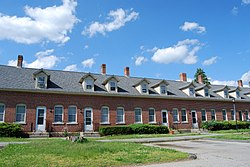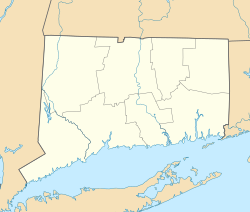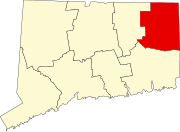Quinebaug Mill–Quebec Square Historic District
Quinebaug Mill–Quebec Square Historic District | |
 Row houses in Quebec Square | |
| Location | Brooklyn, Connecticut |
|---|---|
| Coordinates | 41°47′54″N 71°53′21″W / 41.79833°N 71.88917°W |
| Area | 40 acres (16 ha) |
| Architect | Amos D. Lockwood |
| Architectural style | Greek Revival, Italianate, Queen Anne |
| NRHP reference No. | 85001921[1] |
| Added to NRHP | August 29, 1985 |
Quinebaug Mill–Quebec Square Historic District is a historic district roughly bounded by the Quinebaug River, Quebec Square, and Elm and S. Main Streets in the town of Brooklyn (extending partly into the town of Killingly) in Windham County, Connecticut, United States.[1] The district encompasses a well-preserved 19th-century mill village. It was added to the National Register of Historic Places in 1985.[1]
Description and history
[edit]The district is primarily located within the census-designated place of East Brooklyn and is within the village of Quebec.[2] It consists of the weave shed built by the Quinebaug Mill Company and the surrounding residential area known as Quebec village.[3] The residential portions of the village are characterized by rows of brick mill worker housing, some in long rows of attached housing units, others in smaller combinations housing between two and four units. Stylistically the buildings range from the Greek Revival to the Queen Anne.[4]
The Quinebaug Mill was built by Amos D. Lockwood starting in 1851 on the Quinebaug River, near the site of an 1820 Tiffany Mill.[5] The Quinebaug Mill became one of the largest and most complete cotton mills in Connecticut by the end of the 19th century.[3] Most of the mill was destroyed by fire, but the weave shed and the houses for workers survived.[3] The housing area, which dates back from 1881, was rebuilt as low-cost housing in 1984 and contains six brick row houses, each containing eight apartments, surrounding a green space.[3]
The historic district is considered to be a well-preserved example of a textile mill village, a type of company town that was common in 19th-century eastern Connecticut.[4]
See also
[edit]References
[edit]- ^ a b c "National Register Information System". National Register of Historic Places. National Park Service. April 15, 2008.
- ^ A map of the NRIS polygon vertices overlaid on a Census Bureau map shows that the district is located within and at the eastern edge of the East Brooklyn CDP.
- ^ a b c d Hill Towns and Mill Villages Archived June 12, 2009, at the Wayback Machine, Quinebaug-Shetucket Heritage Corridor, Inc.
- ^ a b Bruce Clouette; Matthew Roth; John Herzan (March 20, 1984). "National Register of Historic Places Inventory-Nomination: Quinebaug Mill–Quebec Square Historic District". National Park Service. and Accompanying 25 photos, from 1985, and one historic birds-eye perspective drawing
- ^ "Killingly Chronology".
- Brooklyn, Connecticut
- Historic districts in Windham County, Connecticut
- Killingly, Connecticut
- Industrial buildings and structures on the National Register of Historic Places in Connecticut
- Company towns in Connecticut
- Cotton mills in the United States
- National Register of Historic Places in Windham County, Connecticut
- Historic districts on the National Register of Historic Places in Connecticut



